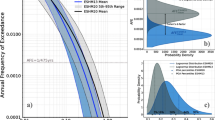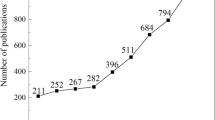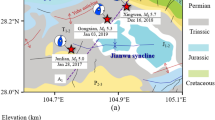Abstract
From the early stage of seismological research, a complex network is one of the statistical methods to investigate the complexity of earthquake systems. The benefit of using this method is to inspect the systems with minimum information about their entities and corresponding interactions. Achieving a high interest in studying the seismic events using the complex network resulted in defining models to map the seismic data into networks. Application of these models to the seismic data sets in nonidentical geographical regions has yielded promising results independent of time and location. In this review, we bring in the recent famous models varying from monolayer to multiplex and compare their proficiency in capturing the complexity of the seismicity by using two data sets from Iran and California.


Similar content being viewed by others
References
Abe S, Okamoto Y (2001) Nonextensive statistical mechanics and its applications, vol 560. Springer, Berlin
Abe S, Suzuki N (2004) Small-world structure of earthquake network. Phys A 337(1–2):357–362
Abe S, Suzuki N (2005) Scale-free statistics of time interval between successive earthquakes. Phys A 350(2–4):588–596
Abe S, Suzuki N (2006) Complex earthquake networks: hierarchical organization and assortative mixing. Phys Rev E 74(2):026113
Abe S, Suzuki N (2012) Dynamical evolution of the community structure of complex earthquake network. Europhys Lett 99(3):39001
Altınok Y (1991) Evaluation of earthquake risk in west anatolia by semi-markov model. Geophysics 5:135–140
Altinok Y, Kolcak D (1999) An application of the semi-markov model for earthquake occurrences in North Anatolia, Turkey. J Balkan Geophys Soc 2(4):90–99
Banavar JR, Maritan A, Rinaldo A (1999) Size and form in efficient transportation networks. Nature 399(6732):130–132
Barabási A-L, Albert R (1999) Emergence of scaling in random networks. Science 286(5439):509–512
Barabási A-L, Bonabeau E (2003) Scale-free networks. Sci Am 288(5):60–69
Billio M, Getmansky M, Lo AW, Pelizzon L (2012) Econometric measures of connectedness and systemic risk in the finance and insurance sectors. J Financ Econ 104(3):535–559
Boccaletti S, Latora V, Moreno Y, Chavez M, Hwang D-U (2006) Complex networks: structure and dynamics. Phys Rep 424(4–5):175–308
Borgatti SP, Mehra A, Brass DJ, Labianca G (2009) Network analysis in the social sciences. Science 323(5916):892–895
Bullmore E, Sporns O (2009) Complex brain networks: graph theoretical analysis of structural and functional systems. Nat Rev Neurosci 10(3):186–198
Cardillo A, Gómez-Gardenes J, Zanin M, Romance M, Papo D, Pozo F, Boccaletti S (2013) Emergence of network features from multiplexity. Sci Rep 3(1):1–6
Costa LF, Oliveira ON Jr, Travieso G, Rodrigues FA, Villas Boas PR, Antiqueira L, Viana MP, Correa Rocha LE (2011) Analyzing and modeling real-world phenomena with complex networks: a survey of applications. Adv Phys 60(3):329–412
Darooneh AH, Lotfi N (2014) Active and passive faults detection by using the pagerank algorithm. Europhys Lett 107(4):49001
De Domenico M, Solé-Ribalta A, Cozzo E, Kivelä M, Moreno Y, Porter MA, Gómez S, Arenas A (2013) Mathematical formulation of multilayer networks. Phys Rev X 3(4):041022
Donges JF, Zou Y, Marwan N, Kurths J (2009) The backbone of the climate network. Europhys Lett 87(4):48007
Donges JF, Donner RV, Kurths J (2013) Testing time series irreversibility using complex network methods. Europhys Lett 102(1):10004
Emmert-Streib F, Dehmer M (2010) Influence of the time scale on the construction of financial networks. PLoS ONE 5(9):e12884
Girvan M, Newman ME (2002) Community structure in social and biological networks. Proc Natl Acad Sci 99(12):7821–7826
Gutenberg B, Richter CF (1944) Frequency of earthquakes in California. Bull Seismol Soc Am 34(4):185–188
Guye M, Bettus G, Bartolomei F, Cozzone PJ (2010) Graph theoretical analysis of structural and functional connectivity mri in normal and pathological brain networks. MAGMA 23(5):409–421
Helmstetter A, Kagan Y, Jackson D (2007) High-resolution time-independent grid-based forecast for m>= 5 earthquakes in California. Seismol Res Lett 78(1):78–86
Herrera C, FA N, Lomnitz C (2006) Time-dependent earthquake hazard evaluation in seismogenic systems using mixed markov chains: an application to the Japan area. Earth Planet Space 58(8):973–979
Jeong H, Mason SP, Barabási A-L, Oltvai ZN (2001) Lethality and centrality in protein networks. Nature 411(6833):41–42
Kagan Y, Jackson D (1994) Long-term probabilistic forecasting of earthquakes. J Geophys Res 99(B7):13685–13700
Kivelä M, Arenas A, Barthelemy M, Gleeson JP, Moreno Y, Porter MA (2014) Multilayer networks. J Complex Netw 2(3):203–271
Lacasa L, Toral R (2010) Description of stochastic and chaotic series using visibility graphs. Phys Rev E 82(3):036120
Lacasa L, Luque B, Ballesteros F, Luque J, Nuno JC (2008) From time series to complex networks: the visibility graph. Proc Natl Acad Sci 105(13):4972–4975
Lacasa L, Luque B, Luque J, Nuno JC (2009) The visibility graph: a new method for estimating the hurst exponent of fractional Brownian motion. Europhys Lett 86(3):30001
Lotfi N (2023) The earthquake network: the best time scale for network construction. arXiv:2301.02073
Lotfi N, Darooneh A (2012) The earthquakes network: the role of cell size. Eur Phys J B 85(1):1–4
Lotfi N, Darooneh AH (2013) Nonextensivity measure for earthquake networks. Phys A 392(14):3061–3065
Lotfi N, Darooneh AH, Rodrigues FA (2018) Centrality in earthquake multiplex networks. Chaos 28(6):063113
Martín FA, Pastén D (2022) Complex networks and the b-value relationship using the degree probability distribution: the case of three mega-earthquakes in chile in the last decade. Entropy 24(3):337
Mello MA, Felix GM, Pinheiro RB, Muylaert RL, Geiselman C, Santana SE, Tschapka M, Lotfi N, Rodrigues FA, Stevens RD (2019) Insights into the assembly rules of a continent-wide multilayer network. Nat Ecol Evol 3(11):1525–1532
Nava FA, Herrera C, Frez J, Glowacka E (2005) Seismic hazard evaluation using Markov chains: application to the Japan area. Pure Appl Geophys 162(6):1347–1366
Omori F (1894) On the aftershocks of earthquakes. J Colloid Interface Sci 7:111–120
Pastén D, Czechowski Z, Toledo B (2018) Time series analysis in earthquake complex networks. Chaos Interdiscip J Nonlinear Sci 28(8):083128
Rezaei S, Darooneh AH, Lotfi N, Asaadi N (2017) The earthquakes network: retrieving the empirical seismological laws. Phys A 471:80–87
Rubinov M, Sporns O (2010) Complex network measures of brain connectivity: uses and interpretations. Neuroimage 52(3):1059–1069
Stein S, Wysession M (2009) An introduction to seismology, earthquakes, and earth structure. Wiley, Hoboken
Szell M, Lambiotte R, Thurner S (2010) Multirelational organization of large-scale social networks in an online world. Proc Natl Acad Sci 107(31):13636–13641
Szklarczyk D, Franceschini A, Wyder S, Forslund K, Heller D, Huerta-Cepas J, Simonovic M, Roth A, Santos A, Tsafou KP et al (2015) String v10: protein–protein interaction networks, integrated over the tree of life. Nucleic Acids Res 43(D1):D447–D452
Telesca L, Lovallo M (2012) Analysis of seismic sequences by using the method of visibility graph. Europhys Lett 97(5):50002
Telesca L, Lovallo M, Aggarwal S, Khan P, Rastogi B (2016) Visibility graph analysis of the 2003–2012 earthquake sequence in the Kachchh region of Western India. Pure Appl Geophys 173(1):125–132
Votsi I, Limnios N, Tsaklidis G, Papadimitriou E (2012) Estimation of the expected number of earthquake occurrences based on semi-Markov models. Methodol Comput Appl Probab 14(3):685–703
Votsi I, Limnios N, Tsaklidis G, Papadimitriou E (2013) Hidden Markov models revealing the stress field underlying the earthquake generation. Phys A 392(13):2868–2885
Votsi I, Limnios N, Tsaklidis G, Papadimitriou E (2014) Hidden semi-Markov modeling for the estimation of earthquake occurrence rates. Commun Stat Theory Methods 43(7):1484–1502
Wang XF, Chen G (2003) Complex networks: small-world, scale-free and beyond. Circuits Syst Mag IEEE 3(1):6–20
Wang X, Koç Y, Derrible S, Ahmad SN, Pino WJ, Kooij RE (2017) Multi-criteria robustness analysis of metro networks. Phys A 474:19–31
Watts DJ, Strogatz SH (1998) Collective dynamics of ‘small-world’networks. Nature 393(6684):440–442
Zhang X, Gan C (2018) Global attractivity and optimal dynamic countermeasure of a virus propagation model in complex networks. Phys A 490:1004–1018
Acknowledgements
N. Lotfi is thankful to the FAPESP (Grant with Number 2020/08359-1) for the support given to this research.
Author information
Authors and Affiliations
Corresponding author
Ethics declarations
Conflict of interest
The authors declare that they have no known competing financial interests or personal relationships that could have appeared to influence the work reported in this paper.
Additional information
Edited by Prof. Norikazu Suzuki (ASSOCIATE EDITOR) / Prof. Ramón Zúñiga (CO-EDITOR-IN-CHIEF).
Rights and permissions
Springer Nature or its licensor (e.g. a society or other partner) holds exclusive rights to this article under a publishing agreement with the author(s) or other rightsholder(s); author self-archiving of the accepted manuscript version of this article is solely governed by the terms of such publishing agreement and applicable law.
About this article
Cite this article
Lotfi, N. Earthquake network construction models: from Abe-Suzuki to a multiplex approach. Acta Geophys. 71, 1111–1117 (2023). https://doi.org/10.1007/s11600-023-01025-4
Received:
Accepted:
Published:
Issue Date:
DOI: https://doi.org/10.1007/s11600-023-01025-4




